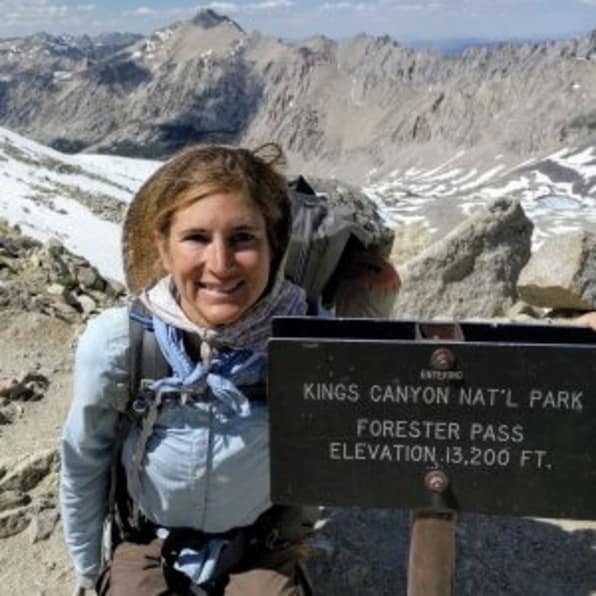How Taking Five Months Off To Hike The Pacific Crest Trail Made Me Better At My Job
Elizabeth Schwartz wants to make it very clear that she didn’t decide to hike the entire Pacific Crest Trail because of Cheryl Strayed’s memoir Wild. “My motivation was very different,” says Schwartz. “I wasn’t looking to find myself or look through emotional baggage. It didn’t feel quite so dramatic.”
That depends on how you define dramatic.
Schwartz, the chief operating officer at Austin-based software startup Square Root (and the first paid employee of the 55-person company), took five months off work to backpack the length of the trail between May and September of last year. In her capacity as COO, Schwartz manages operations, human resources, product, data science, and engineering teams. While no day is typical, she can often be found toggling between strategy and resource planning to hands-on help with teams. So her absence would be felt in all parts of the company.
But Schwartz felt like the time was right to take a corporate sabbatical. She tells Fast Company her initial interest was sparked years ago when she first heard of the trail. “It was one of those things that just struck me like a bolt of lightning,” she recalls. “I couldn’t fall asleep that night,” just thinking about it. But Schwartz confesses she’s not really an avid backpacker. “About 10 years ago I had four weeks off between jobs, and I hiked a quarter of the Appalachian trail by myself,” she says. There were no other extended trips in between. But when her younger brother got laid off from his job and announced he was going to hit the trail, Schwartz starting thinking about it again. ‘For anyone in the middle of a career, the timing is never right,” she muses, “but it may be now or never.” So she starting to plan how to make it work.
Telling Your Boss and Other Logistics
Initially she told Square Root’s founder and CEO Chris Taylor, “I’ll just join my brother for one or two weeks.” But as Schwartz coordinated the short trip, she says the idea of taking a longer time to do the trail in its entirety was too tantalizing to ignore.

Schwartz says Square Root is the kind of company that gives its staff a lot of autonomy, and since it’s small and growing, there was no policy around taking a sabbatical. “We have no vacation policy,” Schwartz explains. “Just take it when you need it.” Schwartz notes that she had no expectations of being paid for the entire time off, but she was paid for part of it. And while she kept her condo, Schwartz points out that backpacking isn’t all that expensive. She estimates it cost her $ 4,000 for the whole trip, including food and equipment.
In part constrained by nature (the trail is only open between April and September because the snow makes it impossible to pass in certain stretches) and business demands (“I needed to make it back to our quarterly meeting,” she notes), Schwartz determined which stretch of time she needed to take off. She worked it out with Taylor, then told the head of HR, but they didn’t share it with the rest of the staff until about a month before Schwartz was scheduled to leave. And even then, it was open-ended, “because so many things are out of your control,” she observes, like how many miles you’ll be able to cover in a day and what could happen with the weather. Schwartz says that the staff was told when Taylor gifted her a compass to mark more than five years with the company, and said simply that she’d be out for “a while in the summer.”

Delegating All Parts Of Your Job
Now it was time to start doling out her responsibilities to other team members. Schwartz is a self professed “die-hard project planner,” and pulls out her spreadsheet to verify that she made 57 delegations to 12 different people for her time away. “It helped to delegate up the chain, sideways, and down,” she notes, because there were good growth opportunities for everyone, including Taylor, the CEO.
Schwartz says that she gave him the task of having one-on-one meetings with key staff, which allowed him to establish more personal connections. More rote tasks such as the company’s accounting processes were outsourced completely.
Schwartz says a lot of work went to Courtney Branson who heads up HR, but the two had previous experience sharing responsibilities when Branson was on maternity leave. In Schwartz’s absence, “Courtney introduced management training,” she says, “and had the clout to lead all the managers with a shared set of best practices.” Those duties ultimately remained with Branson after Schwartz returned. She also revamped performance check-ins, and those no longer involve Schwartz.
Did Schwartz ever worry that her sabbatical might leave her without a role when she returned? “I had to be courageous enough to see I might not be needed,” Schwartz contends. But overall, she says the staff supported and encouraged her.
More broadly, she says, managers could benefit from the thought experiment of having others take on every part of their jobs. “All too often [delegation] degenerates to ‘what I like doing least,’” she observes. Or it can become an exercise in eliminating more junior or rote tasks. But what of the stuff you put your touch on? Would there be someone who could do them better and allow you to focus on something else?
For his part, Taylor maintains that it’s not just harder to replace executives who could take extended time off without fear of losing their jobs. “At Square Root, we empower everyone on the team to pursue their passions, both personally and professionally,” Taylor says. “When we have a special request for an amazing opportunity like Elizabeth’s, our goal is to find a way to say yes–regardless of the person’s title or tenure.”

Not Completely Off The Grid
Schwartz does point out that she was in touch with Square Root staff while she was on the trail (when she had access to Wi-Fi). The longest stretch with no contact was eight days, she says. But otherwise, there weren’t any urgent texts or emails asking her to step in to handle something. When she returned, says Schwartz, “I fit right back in.”
Getting back into the work routine was “a different story,” says Schwartz. She had gotten used to consuming “3,000 calories of sugar and fat” per day while doing all that hiking, and was making hourly trips to Square Root’s snack kitchen.
Her other concern was concentrating. Would she be able to focus in meetings again after all that time spent outdoors? “The increased human connection was really nice instead of walking alone,” Schwartz says. “The only time I really had trouble was reading something for a long period of time, like scrutinizing a contract was a skill I had to relearn.” Fortunately, she’d acquired a treadmill desk back in 2013, and was now spending more time using it.

Long-Term Recharging
And while she wasn’t looking for any big epiphany on the meaning of life, Schwartz says she did find a level of peace that stayed with her long after the trek was over. “I was always go, go, go and task-oriented,” she says of herself before the sabbatical, so much so that she feared she might be bored during the journey. Instead, she says she was able to embrace the relaxation and the joy of discovering what might be around the next bend. “That kind of serenity helps me,” she says. “I can still be task-oriented, but I recognize the value of recharging,” says Schwartz, which could be as simple as doing bootcamp exercise for an hour with other Square Root staff on the front lawn of their offices.
Schwartz says taking a sabbatical was a once-in-a-lifetime experience and she’ll be eternally grateful to the entire team for their support. She hasn’t taken another vacation yet, but notes that she could if she wanted to.
“This is the kind of culture that will keep people there 10 years or more.”
(77)














